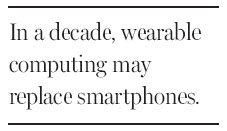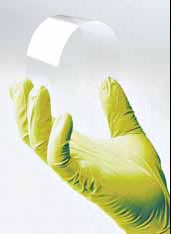Smart watches need flexible glass
Updated: 2013-02-24 07:53
By Nick Bilton(The New York Times)
|
|||||||
|
Corning's Willow Glass can wrap around cylindrical objects, including human wrists. Corning |
James Bond had one. As did Inspector Gadget and Dick Tracy. A watch that doubled as a computer, two-way radio, mapping device or television.
Though such a device has been lost to science fiction comics and spy movies of the era before smartphones, the smart watch might soon become a reality, in the form of a curved glass device made by Apple.
In its headquarters in Cupertino, California, Apple is experimenting with wristwatch-like devices made of curved glass, according to people familiar with the company's explorations. Such a watch would operate on Apple's iOS platform, two people said, and stand apart from competitors based on the company's understanding of how such glass can curve around the human body.
Apple declined to comment on its plans. But the exploration of such a watch leaves open lots of exciting questions: If the company does release such a product, what would it look like? Would it include Siri, the voice assistant? Would it have a version of Apple's map software, offering real-time directions to people walking down the street? Could it receive text messages? Could it monitor a user's health or daily activity? Could it be used to make mobile payments, with Apple's Passbook payment software?
Last year, Corning, the maker of the ultra-tough Gorilla Glass that is used in the iPhone, announced it had solved the engineering challenge of creating bendable glass, called Willow Glass, that can flop as easily as a piece of paper in the wind without breaking.
"You can certainly make it wrap around a cylindrical object and that could be someone's wrist," said Pete Bocko, the chief technology officer for Corning Glass Technologies. "Right now, if I tried to make something that looked like a watch, that could be done using this flexible glass."

But Mr. Bocko warns that it is still quite an engineering feat to create a foldable device. "The human body moves in unpredictable ways," he said. "It's one of the toughest mechanical challenges."
"Over the long term wearable computing is inevitable for Apple; devices are diversifying and the human body is a rich canvas for the computer," said Sarah Rotman Epps, an analyst who specializes in wearable computing and smartphones. "But I'm not sure how close we are to a new piece of Apple hardware that is worn on the body."
Investors would most likely embrace an iWatch, with some already saying that wearable computing could replace the smartphone over the next decade.
"These devices are likely to be cheaper than an iPhone and could ultimately be Apple's best answer to addressing emerging markets," Gene Munster, an analyst, said in a report.
If smartphones do become smart watches and smart glasses, Apple seems to have the technology to make standout wearable computers. Last year Apple the company filed patents for displays that sit over the eye and stream information to the retina. But, maybe there are other devices coming before wearables.
Apple has long been rumored to be working on a television-like experience. And, there is the possibility of an Apple car.
Steven P. Jobs, Apple's co-founder and former chief executive who died in 2011, told John Markoff of The New York Times that if he had more energy, he would have liked to take on Detroit with an Apple car.
In August, Philip W. Schiller, Apple's senior vice president for worldwide product marketing, said Apple explored making "crazy stuff" before the iPhone and iPad, including a camera or a car.
While Apple continues its experiments with wearables, its biggest competitor, Google, is pressing ahead with plans to make wearable computers mainstream. According to a Google executive, the company hopes its wearable glasses, with a display that sits above the eye, will account for 3 percent of revenue by 2015.
Hosain Rahman, chief executive of Jawbone, the maker of the Up, a wrist device that tracks people's energy and sleep, said: "A decade from now we won't be able to imagine life without the wearables that we use to access information, unlock our doors, pay for goods and most importantly track our health."
The New York Times
(China Daily 02/24/2013 page11)
